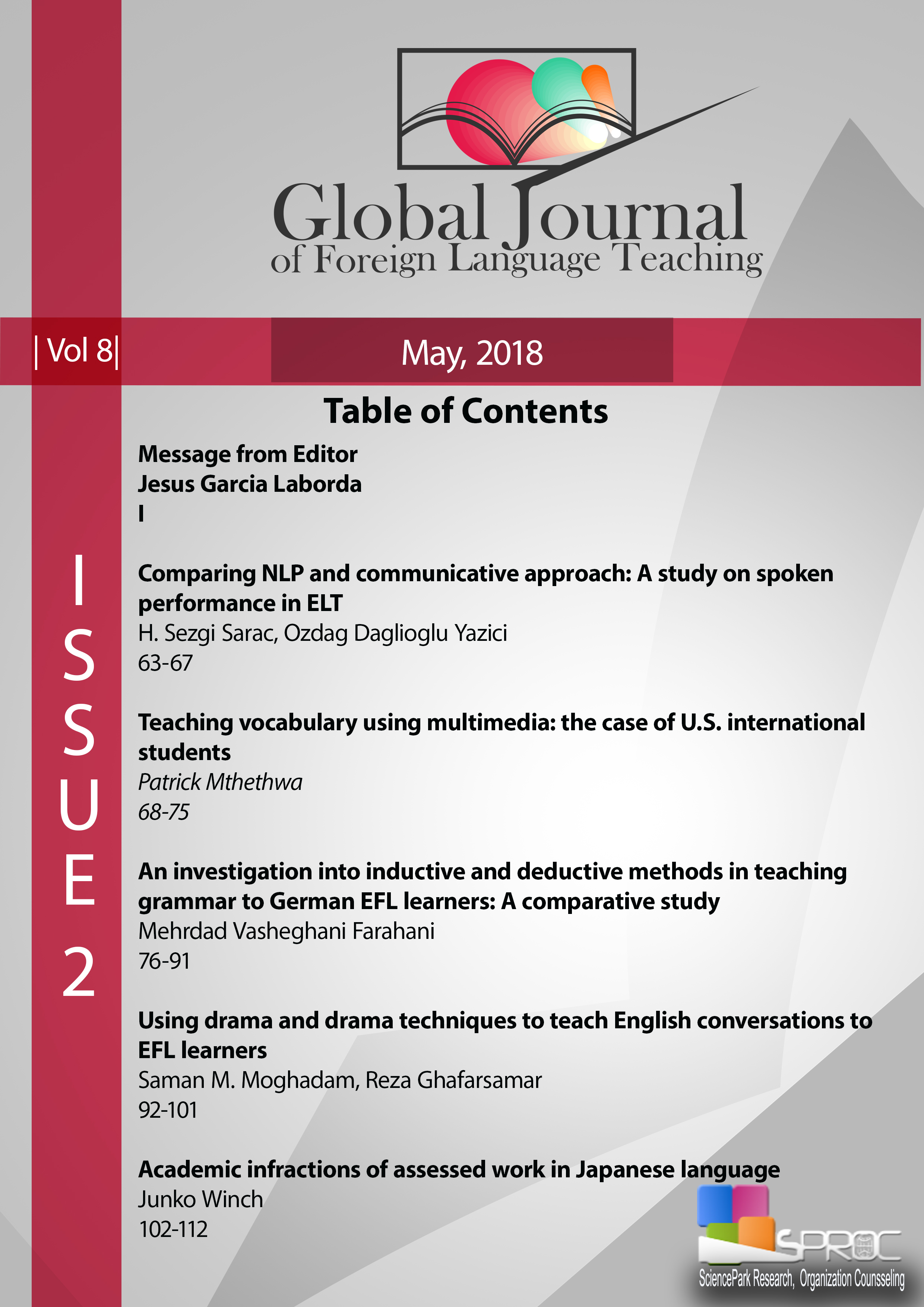Comparing NLP and Communicative Approach: A Study on Spoken Performance in ELT
Main Article Content
Abstract
Applications based on neuro-linguistic programming (NLP) in English language teaching (ELT) provide various means to make
learning more effective and involving. Nevertheless, research on NLP is often based upon descriptive rather than empirical
research. Therefore, the aim of this study is to investigate the efficiency of NLP applications in ELT via comparing it with
communicative approach (CA) to language teaching. In this study, a group of 4th grade students (N = 20) were observed in a
classroom in which CA techniques were applied. The students’ frequency of participation was recorded during two lessons. In
another two classes with the same group of students, the learners’ frequency of participation was evaluated in a classroom
setting where NLP techniques were applied. The results indicate that NLP-related applications are as efficient as CA
applications in achieving high level of learner participation and oral production.
Keywords: Neuro-linguistic programming, language teaching, young learners.
Downloads
Article Details

This work is licensed under a Creative Commons Attribution 4.0 International License.
Authors who publish with this journal agree to the following terms:- Authors retain copyright and grant the journal right of first publication with the work simultaneously licensed under a Creative Commons Attribution License that allows others to share the work with an acknowledgement of the work's authorship and initial publication in this journal.
- Authors are able to enter into separate, additional contractual arrangements for the non-exclusive distribution of the journal's published version of the work (e.g., post it to an institutional repository or publish it in a book), with an acknowledgement of its initial publication in this journal.
- Authors are permitted and encouraged to post their work online (e.g., in institutional repositories or on their website) prior to and during the submission process, as it can lead to productive exchanges, as well as earlier and greater citation of published work (SeeThe Effect of Open Access).
References
Hardingham, A. (1998). Psychology for Trainers. Wiltshire: The Cromwell Press.
Harris, T. (2002). NLP: If it works use it … or is the censorship around? www.hltmag.co.uk/sep02/martsep023.rtf
Hismanoglu, M. (2006). Curent perspectives on pronunciation learning and teaching. Journal of Language and Linguistic Studies. Vol. 2(1), 101-110.
Khanzode, K. (2009). What Neuro Linguistic Programming has to Offer Your Students. British University in Dubai UAE. Vol. XVI. No 2.
Love, M. H. (2001). Neuro linguistic programming: A basis for language learning. The Journal of the Imagination in Language Learning and Teaching. Vol. VI, 100-109.
Millrood, R. (2004). The Role of NLP in Teachers’ Classroom Discourse. ELT Journal. Volume 58/1 January. Oxford University Press.
Revell, J. & Norman, S. (1997). In Your Hands. NLP in ELT. London: Saffire Press.
Revell, J and Nor man, S. (1999). Handing Over. London Saffire Press.
Seliger, H. W. & Shohamy, E. (1995). Second Language Research Methods. Oxford: Oxford University Press.
Richards, J. C. & Rodgers, T. S. (2001). Approaches and Methods in Language Teaching. Cambridge University Press.
Tosey, P. & Mathison, J. (2003). Neuro-linguistic programming: It’s potential for learning and teaching in formal education. The European Conference on Educational Research, University of Hamburg, 17-20 September.
Winch, S. 2005. From Frustration to Satisfaction: Using NLP to Improve Self-Expression. QUT International College / TESOL Unit, School of Cultural and Language Studies, Queensland University of Technology. 18th Annual EA Education Conference, Surry Hills NSW.
